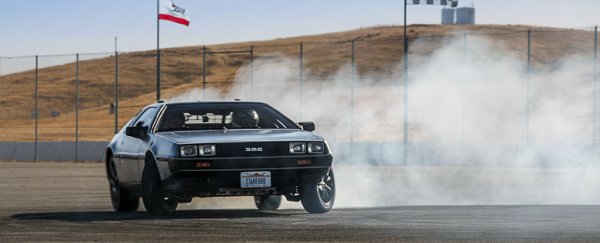This week the world's been celebrating Back to the Future Day in honour of Marty McFly's arrival in 'the future' as depicted in Back to the Future Part II. The date Marty arrives is 21 October 2015, which is now officially in the past for nearly all of us, depending on your timezone. Still with us? Good.
To commemorate the occasion, we compared the state of real technological progress in 2015 with Hill Valley's fictional take on tech in the movie, and Nike went as far as to announce a totally cool new pair of power-lacing sneakers, just like those Marty wears in the film. Back to the Future-mania is well and truly with us.
So what better time for Stanford University in the US to unveil its new self-driving DeLorean? This project might sound a little crazy, but it's actually a serious piece of self-driving research designed to test the limits of autonomous vehicles in extreme driving situations.
MARTY, which stands for "Multiple Actuator Research Test bed for Yaw control", might not include a flux capacitor or retro-looking jet boosters on its tail, but it features things Doc never contemplated incorporating into his own DeLorean time machine, like extreme self-steering controls.
"We want to design automated vehicles that can take any action necessary to avoid an accident," said one of the researchers behind the car, Chris Gerdes, a professor of mechanical engineering. "The laws of physics will limit what the car can do, but we think the software should be capable of any possible manoeuvre within those limits. MARTY is another step in this direction, thanks to the passion and hard work of our students."
While swerving and drifting around corners might not be what most people expect from supposedly safer-than-human self-driving vehicles, it stands to reason that autonomous driving software should know how to handle a car in emergency situations. And drifting around a corner at high speeds might well be called on to save lives in some situations and avoid an otherwise dangerous collision.
"When you watch a pro driver drift a car, you think to yourself that this person really knows how to precisely control the path and angle of the car, despite how different it is from normal driving," said Jonathan Goh, lead research student on the vehicle and part of Gerdes' Dynamic Design Lab. "Autonomous cars need to learn from this in order to truly be as good as the best drivers out there."
Right now, the car's algorithms let it swerve continuously in a precise circular doughnut, and the researchers are working on refining the vehicle's software controls to the point where the DeLorean can drift around a racing circuit at high speed – and even compete against a professional human racer.
Until that point, the car is literally driving in circles, but even that has its advantages.
"The sublime awesomeness of riding in a DeLorean that does perfect smoke-filled doughnuts by itself is a mind-bending experience that helps you appreciate that we really are living in the future," said Goh.
